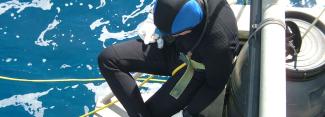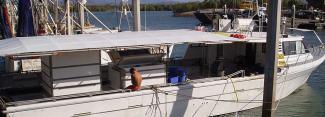



Target Species
| Species | Fishing Mortality* | Biomass** |
|---|---|---|
Black teatfish (Holothuria whitmaei) | Y;Uncertain | Y;Uncertain |
Prickly redfish (Thelenota ananas) | G;Not subject to overfishing | G;Not overfished |
Surf redfish (Actinapyga mauritiana) | Y;Uncertain | Y;Uncertain |
White teatfish (Actinapyga mauritiana) | Y;Uncertain | Y;Uncertain |
| Other sea cucumber species (~11 species) | Y;Uncertain | Y;Uncertain |
Aquarium fishes (more than 500 species) | G;Not subject to overfishing | G;Not overfished |
| Lobster and Trochus Sector | G;Not subject to overfishing | G;Not overfished |
| Line Sector (numerous finfish and shark species) | Y;Uncertain | Y;Uncertain |
* Fishing mortality status relates to the level of fishing pressure on a stock - specifically, whether fishing mortality in the year being assessed is likely to result in the stock becoming overfished, or prevent the stock from rebuilding from an overfished state. If fishing mortality exceeds either of these thresholds, a stock is considered to be subject to overfishing.
** Biomass status relates to how many fish there are - specifically, whether the biomass in the year being assessed is above the level at which the risk to the stock is considered to be unacceptable. The HSP defines this level as the limit reference point, below which the stock is considered to be overfished.
Summary
The Coral Sea Fishery (CSF) is a relatively small but diverse fishery, targeting a wide range of species with methods including line and hand collection. Entry to the CSF is limited to the existing 12 fishing permits.
The CSF extends from Cape York to Sandy Cape, Queensland. It is bounded on the east by the Australian Fishing Zone and on the west by a boundary line 0 to 100 nm east of the eastern boundary of the Great Barrier Reef Marine Park.
Major landing ports
- Mooloolaba
- Townsville
- Cairns.
Markets supplied
- Domestic: fish products (fresh, frozen); aquarium species (live)
- International: South-East Asia (dried sea cucumber [bêche-de-mer]); worldwide (live aquarium species).
Fishing season
12-month season, beginning 1 July.
The Coral Sea Fishery is marked on the map below with diagonal lines.

Management of catch
The Coral Sea Fishery has four sectors that are managed through input and output controls including limited entry, catch limits, spatial closures, move-on provisions, size limits and catch-and-effort triggers that are used to initiate further analysis and assessment.
- Lobster and Trochus Sector
- Line and Trap Sector
- Aquarium Sector
- Sea Cucumber Sector.
Licence to fish
Fishers must hold permits to fish in this fishery. Fishers can only catch species associated with the type of permit they hold.
The fishery has 12 limited entry permits:
- 6 in the Line and Trap Sector
- 2 in the Aquarium Sector
- 2 in the Sea Cucumber Sector
- 2 in the Lobster and Trochus Sector
Collecting data
Data about the catch and effort of the fishery is collected from the logbooks fishers fill out for every fishing shot.
Logbooks record:
- the species and amount caught
- catch that is discarded
- the catch/release of any protected species and their life status
- set and haul times of each shot
- the location of each shot
- the type and amount of gear used.
Species sustainability
The Australian Bureau of Agricultural and Resource Economics (ABARES) independently evaluates the biological and economic status of fish stocks managed solely or jointly by the Australian Government and publishes the results annually in Fishery status reports. This includes an assessment of the Commonwealth Coral Sea Fishery.
Species risk assessments
AFMA regularly monitor the effects fishing activities have on marine species, habitats and communities through ecological risk assessments. The assessment results help to prioritise the management, research, data collection and monitoring needs for the fishery.
After the risk assessment is complete, an ecological risk management strategy is developed to address how AFMA will manage marine species, habitats and communities identified in the assessment as greatly impacted by commercial fishing operations.
Harvest strategies
There are four Coral Sea Fishery harvest strategies:
- Aquarium Sector
- Lobster and Trochus Sector
- Sea Cucumber Sector
- Line, Trawl and Trap Sector.
These aim to keep fish stocks at ecologically sustainable levels and, within that context, maximise the economic returns to the Australian community, and to pursue efficient and cost-effective management.
All harvest strategies are developed in line with the Commonwealth Fisheries Harvest Strategy Policy and Guidelines.
Export approval
To export from an Australian commercial fishery, the fishery must be accredited by the Department of Climate Change, Energy, the Environment and Water under the Environment Protection and Biodiversity Conservation Act 1999 (EPBC Act).
Marine reserves
Commonwealth marine reserves are areas established under Australian environment law to help conserve the spectacular marine life in our oceans. They allow ecologically sustainable use of our marine resources and provide special places for people to enjoy and appreciate the fantastic diversity of our marine habitats.
Marine reserves are sometimes known as marine protected areas or marine parks and are managed by the Department of Climate Change, Energy, the Environment and Water.
More information about marine reserves can be found on the Department of Climate Change, Energy, the Environment and Water website.
Fishing in the fishery
Fishing operators must hold a permit to fish in the fishery.
Download a copy of the latest Coral Sea Fishery Management Arrangements Booklet for a full description of all fishing requirements in the fishery.
AFMA consults industry, scientists, environmental groups and the community for an informed approach to managing the Coral Sea Fishery.
Management publications
Trigger reports
- Coral Sea Fishery 2017–18 Trigger Report
- Coral Sea Fishery 2019–20 Trigger Report
- Coral Sea Fishery 2020–21 Trigger Report
- Coral Sea Fishery 2021–22 Trigger Report
- Coral Sea Fishery 2022–23 Trigger Report
- Coral Sea Fishery 2023–24 Trigger Report
Environmental publications
Onboard observers
One of the main monitoring methods used by AFMA is onboard scientific observers. Observers are people employed by AFMA to go out on boats and independently record catch, effort and biological information of each fishing trip.
They take samples from fish, such as the otoliths or ear bones, and these are used later to determine the age of the fish caught.
Observers also record the length, weight and sex of a sample of the fish caught during a trip and report on the other wildlife that may be seen, the weather conditions, the composition of commercial catch fate of species that are caught as bycatch.
Boats in the Coral Sea Fishery must carry an AFMA observer when requested by AFMA.
Read more about the Observer program.
Satellite tracking
A satellite monitoring system called a Vessel Monitoring System, or VMS for short, is fitted on all concession holders' boats. This system helps AFMA to monitor vessel position, course and speed. The system regularly transmits the information to a database at AFMA.
Read more about our Satellite vessel tracking and monitoring program.
Cameras on fishing boats – electronic monitoring
AFMA has electronic monitoring systems on some fishing boats. These systems have sensors linked to surveillance cameras that record fishing activity. These recordings can then be collected and monitored by AFMA. Electronic monitoring gives fishers a cost-effective way to support monitoring and data collection.
Read more about electronic monitoring of fishing boats.